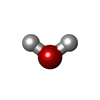+ Open data
Open data
- Basic information
Basic information
| Entry | Database: PDB / ID: 8dcp | ||||||||||||||||||||||||||||||||||||||||||||||||
|---|---|---|---|---|---|---|---|---|---|---|---|---|---|---|---|---|---|---|---|---|---|---|---|---|---|---|---|---|---|---|---|---|---|---|---|---|---|---|---|---|---|---|---|---|---|---|---|---|---|
| Title | PI 3-kinase alpha with nanobody 3-126 | ||||||||||||||||||||||||||||||||||||||||||||||||
 Components Components |
| ||||||||||||||||||||||||||||||||||||||||||||||||
 Keywords Keywords | TRANSFERASE / Phosphoinositide 3-kinase (PI3K) / activation / inhibition / nanobody / conformational changes / STRUCTURAL PROTEIN | ||||||||||||||||||||||||||||||||||||||||||||||||
| Function / homology |  Function and homology information Function and homology informationperinuclear endoplasmic reticulum membrane / regulation of toll-like receptor 4 signaling pathway / response to muscle inactivity / phosphatidylinositol kinase activity / regulation of actin filament organization / negative regulation of actin filament depolymerization / positive regulation of focal adhesion disassembly / response to butyrate / response to L-leucine / 1-phosphatidylinositol-3-kinase regulator activity ...perinuclear endoplasmic reticulum membrane / regulation of toll-like receptor 4 signaling pathway / response to muscle inactivity / phosphatidylinositol kinase activity / regulation of actin filament organization / negative regulation of actin filament depolymerization / positive regulation of focal adhesion disassembly / response to butyrate / response to L-leucine / 1-phosphatidylinositol-3-kinase regulator activity / phosphatidylinositol 3-kinase regulator activity / IRS-mediated signalling / positive regulation of endoplasmic reticulum unfolded protein response / phosphatidylinositol 3-kinase activator activity / interleukin-18-mediated signaling pathway / T follicular helper cell differentiation / phosphatidylinositol 3-kinase complex / PI3K events in ERBB4 signaling / phosphatidylinositol 3-kinase regulatory subunit binding / autosome genomic imprinting / myeloid leukocyte migration / cellular response to hydrostatic pressure / neurotrophin TRKA receptor binding / regulation of cellular respiration / Activated NTRK2 signals through PI3K / cis-Golgi network / negative regulation of fibroblast apoptotic process / Activated NTRK3 signals through PI3K / transmembrane receptor protein tyrosine kinase adaptor activity / phosphatidylinositol 3-kinase complex, class IB / ErbB-3 class receptor binding / positive regulation of protein localization to membrane / vasculature development / 1-phosphatidylinositol-4-phosphate 3-kinase activity / Signaling by cytosolic FGFR1 fusion mutants / Co-stimulation by ICOS / RHOD GTPase cycle / cardiac muscle cell contraction / phosphatidylinositol 3-kinase complex, class IA / Nephrin family interactions / RHOF GTPase cycle / Signaling by LTK in cancer / anoikis / kinase activator activity / phosphatidylinositol-3-phosphate biosynthetic process / Signaling by LTK / positive regulation of leukocyte migration / MET activates PI3K/AKT signaling / relaxation of cardiac muscle / PI3K/AKT activation / 1-phosphatidylinositol-4,5-bisphosphate 3-kinase activity / RND1 GTPase cycle / negative regulation of stress fiber assembly / RND2 GTPase cycle / phosphatidylinositol-4,5-bisphosphate 3-kinase / RND3 GTPase cycle / vascular endothelial growth factor signaling pathway / positive regulation of filopodium assembly / phosphatidylinositol 3-kinase / growth hormone receptor signaling pathway / insulin binding / Signaling by ALK / 1-phosphatidylinositol-3-kinase activity / RHOV GTPase cycle / PI-3K cascade:FGFR3 / Erythropoietin activates Phosphoinositide-3-kinase (PI3K) / RHOB GTPase cycle / natural killer cell mediated cytotoxicity / GP1b-IX-V activation signalling / negative regulation of macroautophagy / PI-3K cascade:FGFR2 / response to dexamethasone / PI-3K cascade:FGFR4 / phosphatidylinositol-mediated signaling / PI-3K cascade:FGFR1 / RHOC GTPase cycle / RHOJ GTPase cycle / intracellular glucose homeostasis / phosphatidylinositol phosphate biosynthetic process / negative regulation of osteoclast differentiation / Synthesis of PIPs at the plasma membrane / RHOU GTPase cycle / RET signaling / CDC42 GTPase cycle / negative regulation of anoikis / Interleukin-3, Interleukin-5 and GM-CSF signaling / insulin receptor substrate binding / PI3K Cascade / PI3K events in ERBB2 signaling / intercalated disc / T cell differentiation / negative regulation of cell-matrix adhesion / RHOG GTPase cycle / extrinsic apoptotic signaling pathway via death domain receptors / regulation of multicellular organism growth / CD28 dependent PI3K/Akt signaling / RHOA GTPase cycle / Role of LAT2/NTAL/LAB on calcium mobilization / RAC2 GTPase cycle / RAC3 GTPase cycle Similarity search - Function | ||||||||||||||||||||||||||||||||||||||||||||||||
| Biological species |  Homo sapiens (human) Homo sapiens (human) | ||||||||||||||||||||||||||||||||||||||||||||||||
| Method | ELECTRON MICROSCOPY / single particle reconstruction / cryo EM / Resolution: 2.41 Å | ||||||||||||||||||||||||||||||||||||||||||||||||
 Authors Authors | Hart, J.R. / Liu, X. / Pan, C. / Liang, A. / Ueno, L. / Xu, Y. / Quezada, A. / Zou, X. / Yang, S. / Zhou, Q. ...Hart, J.R. / Liu, X. / Pan, C. / Liang, A. / Ueno, L. / Xu, Y. / Quezada, A. / Zou, X. / Yang, S. / Zhou, Q. / Schoonooghe, S. / Hassanzadeh-Ghassabeh, G. / Xia, T. / Shui, W. / Yang, D. / Vogt, P.K. / Wang, M.-W. | ||||||||||||||||||||||||||||||||||||||||||||||||
| Funding support |  United States, United States,  China, 15items China, 15items
| ||||||||||||||||||||||||||||||||||||||||||||||||
 Citation Citation |  Journal: Proc Natl Acad Sci U S A / Year: 2022 Journal: Proc Natl Acad Sci U S A / Year: 2022Title: Nanobodies and chemical cross-links advance the structural and functional analysis of PI3Kα. Authors: Jonathan R Hart / Xiao Liu / Chen Pan / Anyi Liang / Lynn Ueno / Yingna Xu / Alexandra Quezada / Xinyu Zou / Su Yang / Qingtong Zhou / Steve Schoonooghe / Gholamreza Hassanzadeh-Ghassabeh / ...Authors: Jonathan R Hart / Xiao Liu / Chen Pan / Anyi Liang / Lynn Ueno / Yingna Xu / Alexandra Quezada / Xinyu Zou / Su Yang / Qingtong Zhou / Steve Schoonooghe / Gholamreza Hassanzadeh-Ghassabeh / Tian Xia / Wenqing Shui / Dehua Yang / Peter K Vogt / Ming-Wei Wang /     Abstract: Nanobodies and chemical cross-linking were used to gain information on the identity and positions of flexible domains of PI3Kα. The application of chemical cross-linking mass spectrometry (CXMS) ...Nanobodies and chemical cross-linking were used to gain information on the identity and positions of flexible domains of PI3Kα. The application of chemical cross-linking mass spectrometry (CXMS) facilitated the identification of the p85 domains BH, cSH2, and SH3 as well as their docking positions on the PI3Kα catalytic core. Binding of individual nanobodies to PI3Kα induced activation or inhibition of enzyme activity and caused conformational changes that could be correlated with enzyme function. Binding of nanobody Nb3-126 to the BH domain of p85α substantially improved resolution for parts of the PI3Kα complex, and binding of nanobody Nb3-159 induced a conformation of PI3Kα that is distinct from known PI3Kα structures. The analysis of CXMS data also provided mechanistic insights into the molecular underpinning of the flexibility of PI3Kα. | ||||||||||||||||||||||||||||||||||||||||||||||||
| History |
|
- Structure visualization
Structure visualization
| Structure viewer | Molecule:  Molmil Molmil Jmol/JSmol Jmol/JSmol |
|---|
- Downloads & links
Downloads & links
- Download
Download
| PDBx/mmCIF format |  8dcp.cif.gz 8dcp.cif.gz | 265 KB | Display |  PDBx/mmCIF format PDBx/mmCIF format |
|---|---|---|---|---|
| PDB format |  pdb8dcp.ent.gz pdb8dcp.ent.gz | 194.7 KB | Display |  PDB format PDB format |
| PDBx/mmJSON format |  8dcp.json.gz 8dcp.json.gz | Tree view |  PDBx/mmJSON format PDBx/mmJSON format | |
| Others |  Other downloads Other downloads |
-Validation report
| Summary document |  8dcp_validation.pdf.gz 8dcp_validation.pdf.gz | 1.1 MB | Display |  wwPDB validaton report wwPDB validaton report |
|---|---|---|---|---|
| Full document |  8dcp_full_validation.pdf.gz 8dcp_full_validation.pdf.gz | 1.1 MB | Display | |
| Data in XML |  8dcp_validation.xml.gz 8dcp_validation.xml.gz | 36 KB | Display | |
| Data in CIF |  8dcp_validation.cif.gz 8dcp_validation.cif.gz | 55.9 KB | Display | |
| Arichive directory |  https://data.pdbj.org/pub/pdb/validation_reports/dc/8dcp https://data.pdbj.org/pub/pdb/validation_reports/dc/8dcp ftp://data.pdbj.org/pub/pdb/validation_reports/dc/8dcp ftp://data.pdbj.org/pub/pdb/validation_reports/dc/8dcp | HTTPS FTP |
-Related structure data
| Related structure data |  27327MC  8dcxC  8dd4C  8dd8C M: map data used to model this data C: citing same article ( |
|---|---|
| Similar structure data | Similarity search - Function & homology  F&H Search F&H Search |
- Links
Links
- Assembly
Assembly
| Deposited unit | 
|
|---|---|
| 1 |
|
- Components
Components
| #1: Protein | Mass: 127822.578 Da / Num. of mol.: 1 Source method: isolated from a genetically manipulated source Source: (gene. exp.)  Homo sapiens (human) / Gene: PIK3CA / Production host: Homo sapiens (human) / Gene: PIK3CA / Production host:  Trichoplusia ni (cabbage looper) Trichoplusia ni (cabbage looper)References: UniProt: P42336, phosphatidylinositol-4,5-bisphosphate 3-kinase, non-specific serine/threonine protein kinase |
|---|---|
| #2: Protein | Mass: 83623.203 Da / Num. of mol.: 1 Source method: isolated from a genetically manipulated source Source: (gene. exp.)  Homo sapiens (human) / Gene: PIK3R1, GRB1 / Production host: Homo sapiens (human) / Gene: PIK3R1, GRB1 / Production host:  Trichoplusia ni (cabbage looper) / References: UniProt: P27986 Trichoplusia ni (cabbage looper) / References: UniProt: P27986 |
| #3: Water | ChemComp-HOH / |
-Experimental details
-Experiment
| Experiment | Method: ELECTRON MICROSCOPY |
|---|---|
| EM experiment | Aggregation state: PARTICLE / 3D reconstruction method: single particle reconstruction |
- Sample preparation
Sample preparation
| Component | Name: Human PI 3-kinase alpha complex composed of p110alpha and p85alpha with nanobody 3-126 bound Type: COMPLEX / Entity ID: #1-#2 / Source: RECOMBINANT |
|---|---|
| Molecular weight | Experimental value: NO |
| Source (natural) | Organism:  Homo sapiens (human) Homo sapiens (human) |
| Source (recombinant) | Organism:  Trichoplusia ni (cabbage looper) / Strain: Sf-9 Trichoplusia ni (cabbage looper) / Strain: Sf-9 |
| Buffer solution | pH: 7.6 |
| Specimen | Conc.: 1 mg/ml / Embedding applied: NO / Shadowing applied: NO / Staining applied: NO / Vitrification applied: YES |
| Vitrification | Cryogen name: ETHANE |
- Electron microscopy imaging
Electron microscopy imaging
| Experimental equipment |  Model: Titan Krios / Image courtesy: FEI Company |
|---|---|
| Microscopy | Model: FEI TITAN KRIOS |
| Electron gun | Electron source: OTHER / Accelerating voltage: 300 kV / Illumination mode: OTHER |
| Electron lens | Mode: BRIGHT FIELD / Nominal defocus max: 2500 nm / Nominal defocus min: 1500 nm |
| Image recording | Electron dose: 70 e/Å2 / Film or detector model: GATAN K3 (6k x 4k) |
- Processing
Processing
| Software |
| ||||||||||||||||||||||||
|---|---|---|---|---|---|---|---|---|---|---|---|---|---|---|---|---|---|---|---|---|---|---|---|---|---|
| EM software |
| ||||||||||||||||||||||||
| CTF correction | Type: PHASE FLIPPING AND AMPLITUDE CORRECTION | ||||||||||||||||||||||||
| 3D reconstruction | Resolution: 2.41 Å / Resolution method: DIFFRACTION PATTERN/LAYERLINES / Num. of particles: 506412 / Symmetry type: POINT | ||||||||||||||||||||||||
| Atomic model building | B value: 43.84 / Protocol: FLEXIBLE FIT / Space: REAL / Target criteria: Correlation coefficient | ||||||||||||||||||||||||
| Atomic model building | PDB-ID: 7MYN Accession code: 7MYN / Source name: PDB / Type: experimental model | ||||||||||||||||||||||||
| Refinement | Cross valid method: NONE Stereochemistry target values: GeoStd + Monomer Library + CDL v1.2 | ||||||||||||||||||||||||
| Displacement parameters | Biso mean: 43.8 Å2 | ||||||||||||||||||||||||
| Refine LS restraints |
|
 Movie
Movie Controller
Controller






 PDBj
PDBj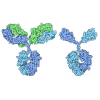





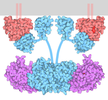



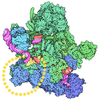
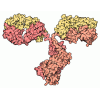



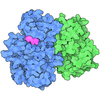
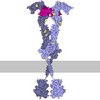
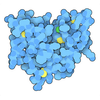

 gel filtration
gel filtration